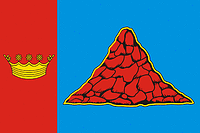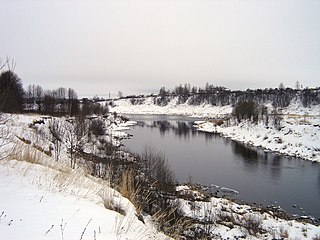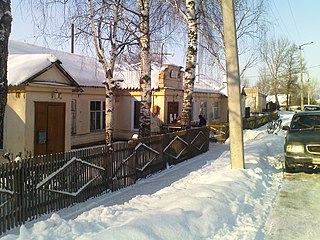Coordinates: 58°18′40.5″N37°52′52.6″E / 58.311250°N 37.881278°E

A geographic coordinate system is a coordinate system that enables every location on Earth to be specified by a set of numbers, letters or symbols. The coordinates are often chosen such that one of the numbers represents a vertical position and two or three of the numbers represent a horizontal position; alternatively, a geographic position may be expressed in a combined three-dimensional Cartesian vector. A common choice of coordinates is latitude, longitude and elevation. To specify a location on a plane requires a map projection.


The Sit' River (Сить) is a tributary of the Rybinsk Reservoir (nominally, of the Mologa River). The river flows for 159 kilometres (99 mi) through Sonkovsky District of Tver Oblast and Nekouzsky and Breytovsky Districts of Yaroslavl Oblasts of Russia before entering the Rybinsk Reservoir near the large village of Breitovo. Its average width varies from 40 to 50 metres (130 to 160 ft). [1] The river mouth is about 1,500 metres (4,900 ft) wide. The drainage basin occupies some 1,900 square kilometres (730 sq mi). [1] The river is 159 kilometres (99 mi) long. [2]

Rybinsk Reservoir, informally called the Rybinsk Sea, is a water reservoir on the Volga River and its tributaries Sheksna and Mologa, formed by Rybinsk Hydroelectric Station dam, located in the Tver, Vologda, and Yaroslavl Oblasts. At the time of its construction, it was the largest man-made body of water on Earth. It is the northernmost point of the Volga. The Volga-Baltic Waterway starts from there. The principal ports are Cherepovets in Vologda Oblast and Vesyegonsk in Tver Oblast.

The Mologa is a river in Maksatikhinsky, Bezhetsky, Lesnoy, and Sandovsky Districts of Tver Oblast, Pestovsky District in Novgorod Oblast, and Ustyuzhensky and Cherepovetsky Districts in Vologda Oblast Russia. It is a left tributary of the Volga River. The lower course of the Mologa has been turned into the Rybinsk Reservoir. It is 456 kilometres (283 mi) long, and the area of its basin 29,700 square kilometres (11,500 sq mi). The principal tributaries of the Mologa are the Osen (right), the Volchina (left), the Kobozha (left), the Chagodoshcha (left) and the Sit.

Sonkovsky District is an administrative and municipal district (raion), one of the thirty-six in Tver Oblast, Russia. It is located in the east of the oblast and borders with Krasnokholmsky District in the north, Nekouzsky District of Yaroslavl Oblast in the east, Kesovogorsky District in the south, and with Bezhetsky District in the west. The area of the district is 970 square kilometers (370 sq mi). Its administrative center is the urban locality of Sonkovo. Population: 8,553 ; 10,523 (2002 Census); 13,570 (1989 Census). The population of Sonkovo accounts for 48.7% of the district's total population.
The river gives its name to the bloody Battle of the Sit River (1238). In the Middle Ages the valley of the Sit River belonged to a branch of the princely House of Yaroslavl. The princes of the Sit', or Sitsky, joined the service of the Grand Dukes of Muscovy in the 15th century. The family survived into the 17th century and was closely related by blood to the Romanovs. [3]

The Battle of the Sit River was fought in the northern part of the present-day Sonkovsky District of Tver Oblast of Russia, close to the selo of Bozhonka, on March 4, 1238 between the Mongol Hordes of Batu Khan and the Rus' under Grand Prince Yuri II of Vladimir-Suzdal during the Mongol invasion of Rus.
The source of the Sit is in the north of Sonkovsky District, close to the village of Saburovo. The river flows northeast, enters Yaroslavl Oblast, and turns south. By the selo of Voznesenskoye it turns east and eventually north. The mouth of the Sit is in the selo of Breytovo. Before the Rybinsk Reservoir was filled, the Sit was a tributary of the Mologa River.
The drainage basin of the sit includes the eastern part of Krasnokholmsky District of Tver Oblast, the eastern part of Sonkovsky District, the western part of Nekouzsky District, and some areas in Breytovsky District. The district centers Sonkovo and Breytovo lie in the drainage basin of the Sit.

Krasnokholmsky District is an administrative and municipal district (raion), one of the thirty-six in Tver Oblast, Russia. It is located in the northeast of the oblast and borders with Vesyegonsky District in the north, Breytovsky District of Yaroslavl Oblast in the northeast, Nekouzsky District, also of Yaroslavl Oblast, in the southeast, Sonkovsky District in the south, Bezhetsky District in the southwest, and with Molokovsky District in the northwest. The area of the district is 1,495 square kilometers (577 sq mi). Its administrative center is the town of Krasny Kholm. Population: 11,835 ; 14,736 (2002 Census); 18,813 (1989 Census). The population of Krasny Kholm accounts for 47.4% of the district's total population.

Sonkovo is an urban locality and the administrative center of Sonkovsky District of Tver Oblast, Russia. Population: 4,164 (2010 Census); 4,577 (2002 Census); 5,988 (1989 Census).
In the early 20th century the valley of the Sit River was home to the Sitskari (ru), an ethnic group of short fair-haired people speaking a Northern dialect of the Russian language. It is thought that they had a mixture of Lithuanian or some other Baltic ancestry. [4]

The northern Russian dialects make up one of the main groups of the Russian dialects.

Russian is an East Slavic language, which is official in the Russian Federation, Belarus, Kazakhstan and Kyrgyzstan, as well as being widely used throughout Eastern Europe, the Baltic states, the Caucasus and Central Asia. It was the de facto language of the Soviet Union until its dissolution on 25 December 1991. Although, nowadays, over two decades after the breakup of the Soviet Union, Russian is used in official capacity or in public life in all the post-Soviet nation-states, as well as in Israel and Mongolia, the rise of state-specific varieties of this language tends to be strongly denied in Russia, in line with the Russian World ideology.

Lithuania, officially the Republic of Lithuania, is a country in the Baltic region of Europe. Since its independence, Lithuania is considered to be one of the Baltic states. It is situated along the southeastern shore of the Baltic Sea, to the east of Sweden and Denmark. It is bordered by Latvia to the north, Belarus to the east and south, Poland to the south, and Kaliningrad Oblast to the southwest. Lithuania has an estimated population of 2.7 million people as of 2019, and its capital and largest city is Vilnius. Other major cities are Kaunas and Klaipėda. Lithuanians are Baltic people. The official language, Lithuanian, along with Latvian, is one of only two living languages in the Baltic branch of the Indo-European language family.










